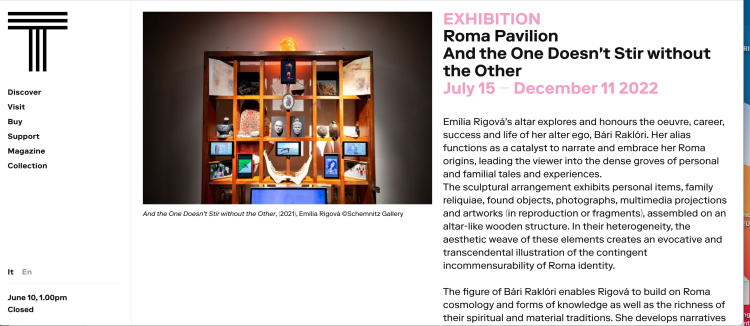Roma Pavilion at the 23rd International Art Exhibition Triennale Milano: Emília Rigová: And the One Doesn’t Stir without the Other

The European Roma Institute for Arts and Culture (ERIAC) presents Emília Rigová: And the One Doesn’t Stir without the Other, curated by Timea Junghaus, an official Roma exhibition at the 23rd Triennale Milano International Exhibition.
The exhibition comprises installation, video, photography, found objects, and a community art project. At the centre is the altar honouring the oeuvre, career, and life of Bári Raklóri (“bári”=big, “raklóri”=daughter of non-Roma parents), the artist’s alter ego which has become a leitmotif of her visual work over the past decade. Referring to Rigová’s Roma origin and family history, the persona of Bári Raklóri allows the artist to evade the collective Roma identity as a minoritarian artist and facilitates acts of self-definition and freedom. Her alias functions as a catalyst to narrate and embrace her Roma origins, connecting her individual experience to the stories shared by members of the Milanese Roma community invited to contribute to the project by mounting their own altars, and displaying personal memories and stories, thus illuminating the intangibility of their polyphonic community. The altar formula provides a sumptuous yet probing vehicle to evoke the complexity of such concepts as identity, authenticity, ethnicity, representation, hybridity, race, class, migration, globalisation, and power. Building on Roma cosmology and forms of knowledge, and delving into the richness of their spiritual and material traditions, Rigová aptly uses the stories evoked by the altars to cultivate a self-determined imaginarium of Europe’s largest ethnic minority. In elaborating hidden Roma stories rooted in affective familial rhizomes, the artist reveals their entanglement with overarching historical, national narratives. Through her collaboration with the local community, the exhibition unfolds as a site-specific Wunderkammer, the tangible materialisation of diversity of Roma identities and experiences, despite the homogenizing majoritarian narrative.
Emília Rigová is a visual artist from the Slovak Republic, and she also teaches art at Matej Bel University in Banská Bystrica. For Rigová, an object in the form of an installation, a performance, or a site-specific intervention is a basic element of her art language, as is the 2D interface of computer graphics, informed by the foundation of classical painting. She explores the intersubjectivity of emotions mediated by a specific socio-cultural environment, as she focuses the gaze on cultural and social stereotypes, Romani identity, and the psychology of the individual. She is a laureate of the Oskár Čepan Award and of Roma Spirit, both awarded in 2018.
Tímea Junghaus is an art historian and art curator. Junghaus received the Kairos—European Cultural Prize from the Alfred Toepfer Stiftung in 2008. Curatorial work includes the Roma component of the Hidden Holocaust exhibition in the Budapest Kunsthalle (2004), Paradise Lost—the First Roma Pavilion at the 52nd Venice Biennale (2007), and The Romani Elders and the Public Intervention for the Unfinished Memorial to the Sinti and Roma Murdered Under the National Socialist Regime at the 7th Berlin Biennale (2012). She is curator of the Visual Arts Section for RomArchive—Digital Archive of the Roma. Junghaus was the founding director of Gallery8—Roma Contemporary Art Space in Budapest (2013-2017), the winner of the 2014 Catalyst Contemporary Art Award (tranzit Hungary), and the 2014 Otto Pankok Prize awarded by the For Roma Foundation of German writer and Literary Nobel Laureate, Günter Grass. She has been Executive Director of the European Roma Institute for Arts and Culture since 2017.
The European Roma Institute for Arts and Culture (ERIAC), as a joint initiative of the Council of Europe, the Open Society Foundations, and the Roma Leaders’ initiative—Alliance for the European Roma Institute for Arts and Culture, has a unique mandate as the transnational, European-level organisation for the recognition of Roma through the means of arts and culture. ERIAC supports a broad network of Roma individuals and organisations working in the fields of arts and culture, giving space to a contemporary art gallery and educational programmes. ERIAC exists to increase the self-esteem of Roma and to decrease negative prejudice of the majority population towards the Roma through arts, culture, history, and language education.
With support from: Slovak Institute in Rome
https://eriac.org/milantriennale/

[…] Next Blog Entry […]
[…] Previous Blog Entry […]